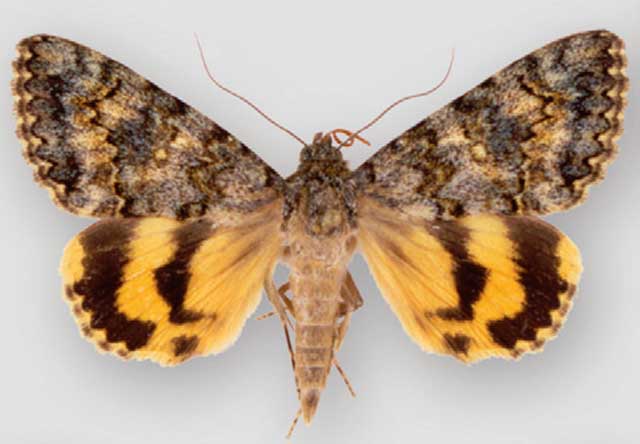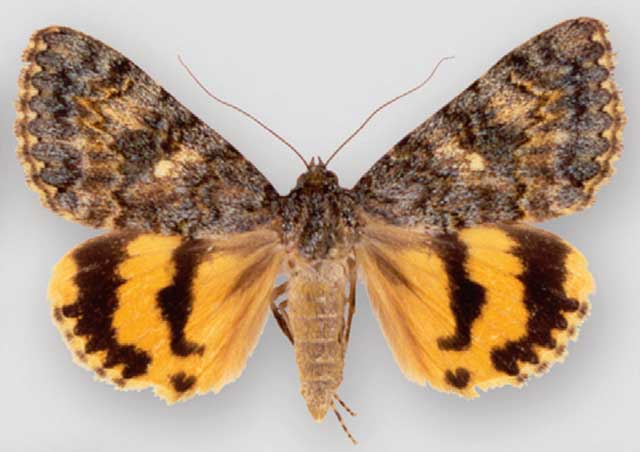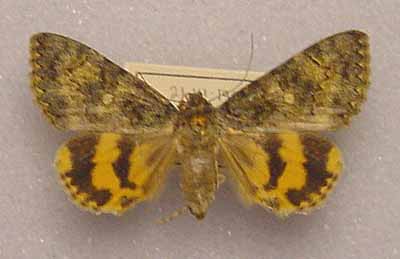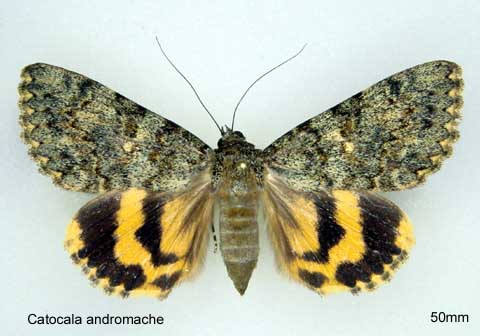Catocala andromache
Catocala andromache
kah-TOCK-uh-lahman-DROM-eh-chee
Henry
Edwards, 1885

Catocala andromache male, California,
courtesy of David Hawks.
This site has been created by
Bill Oehlke.
Comments, suggestions and/or additional information are welcomed by Bill.
| TAXONOMY:
Superfamily: Noctuoidea
Family: Erebidae, Leach, [1815]
Subfamily: Erebinae, Leach, [1815]
Tribe: Catocalini, Boisduval, [1828]
Genus: Catocala, Schrank, 1802
|
DISTRIBUTION:
Catocala andromache
(wingspan: 50-55mm) flies in mountainous southern and central
California: San Diego, Riverside, San Bernardino, Los Angeles northward
along the southern Coast Ranges and the Sierra Nevada of California to Amador, Butte, Calaveras, Kern, Lake, Los Angeles,
Mariposa, Nevada, Santa Barbara, Solano,
Ventura and Yolo counties.
"The only closely similar taxon to C. andromache is C. b. benjamini.
The dorsal forewing of C. andromache is usually liberally speckled with greenish scales
(in many freshly eclosed specimens the wings are a mottled moss green), whereas
the dorsal forewing of C. b. benjamini is sparsely speckled with bluish scales. This
distinction breaks down for worn specimens, and for many specimens from desert
edge mountains in southern California. However, C. andromache is not sympatric
with C. b. benjamini. Catocala andromache is sympatric with C. b. mayhewi along the
desert slopes of the mountains of southern California, and there the two species are
consistently separated by the larger size, darker forewings, darker yellowish bands,
and wider black bands of C. andromache.
"The name wellsi was proposed for specimens
with more blackish, unmottled forewings from the central Sierran foothills, but these
characteristics break down in larger series and there seems little merit in retaining the
name at subspecific rank." David Hawks
This moth flies mostly below 2000m.
Others have reported them in
Arizona;
Wayne H. Whaley reports them in Utah.
However, David C. Hawks does not confirm populations outside of California. Specimens
designated as C. andromache in Utah and Arizona are more likely a different, similar species.
I am pretty sure the "andromache" depicted by Bruce Walsh from Arizona has been re-evaluated as C. caesia.
The moths previously identified as subspecies Catocala andromache wellsi, flying
in central California, are now synonymized with the nominate species.
FLIGHT TIMES AND PREFERRED FOOD PLANTS:
Catocala andromache are usually on the wing from mid June through August.
The Catocala andromache caterpillar shows a preference
for oaks. They have been collected on Quercus chrysolepis
Liebm. They also probably feed on Quercus cornelius-mulleri, Q. dumosa Nutt., and Q.
wislizenii A. de Candolle, among others.
ECLOSION:
Adults eclose from pupae at soil surface.

Catocala andromache female, California,
courtesy of David Hawks.
SCENTING AND MATING:Catocala
andromache females emit an airbourne pheromone and males use
their antennae to track the scent plume.
Catocala andromache (male) Miracle Hot Springs, 2320'
Kern County, CA, July 4 1989. Kelly Richers, collector, at uv light.
|  |
EGGS, CATERPILLARS, COCOONS AND PUPAE:
Eggs are deposited on
tree bark in the fall and hatch the following spring.
Larval Food Plants
Listed below are primary food plant(s) and alternate food plants.
It is hoped that this alphabetical listing followed by the common
name of the foodplant will prove useful. The list is not exhaustive,
although some species seem very host specific.
Experimenting with closely related foodplants is worthwhile.
Quercus chrysolepis
Quercus cornelius-mulleri .......
Quercus dumosa
Quercus turbinella
Quercus wislizeni
|
Canyon live oak
Mullers Scrub Oak
California scrub oak
Shrub live oak
Interior live oak
|
Return to Main Index
This page is brought to you by Bill Oehlke and the
WLSS. Pages are on space rented from Bizland. If you would like
to become a "Patron of the Sphingidae/Catocala Sites",
contact Bill.
Please send sightings/images to Bill. I will do my best to respond to
requests for identification help.
Enjoy one of nature's wonderments: Live
Saturniidae (Giant Silkmoth) cocoons.

|

To show appreciation for this site, click on the flashing
butterfly to the left, a link
to many worldwide insect sites. |

Catocala andromache, courtesy of "California Pappy".
Visit Catocala delilah Species Complex; Author: David Hawks.
Visit California Catocala
immatures





